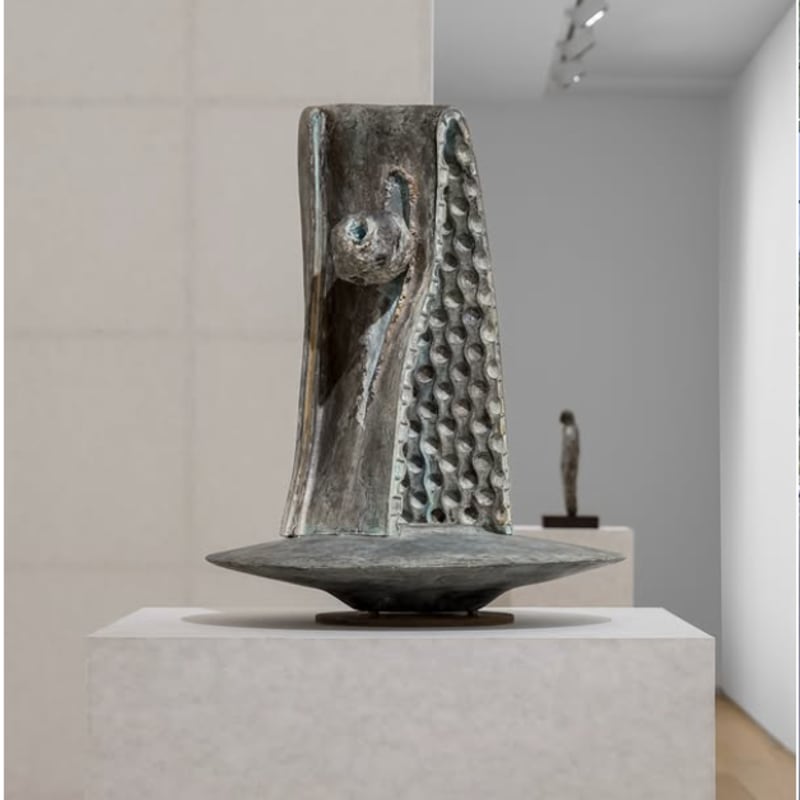Ilya and Emilia Kabakov Cupola
THE CUPOLA, 2003
Ilya and Emilia Kabakov’s The Cupola is a large mixed-media installation which resembles a rose window: in the center, in the depths of the cupola, there is a white aperture from which colored “beams” radiate in all directions; their colors change, in infinite variations, in concert with the music played under the cupola. The work is based on the ideas of the great Russian composer Scriabin, and other composers of the 1920s and 1930s, on the connection between sound and color. Originally conceived for the Ruhrtriennale, in Bochum, in 2003, it has been exhibited at the Madrid Arena in 2011 and at the Grand Palais, Paris in 2014. Beside its sculptural value, The Cupola is also considered by its creators as a site for other artistic and creative events. It is a “Gesamtkunstwerk” (“total work of art”) that unites visual, musical and performance art, reflecting on the experimental utopian projects of the early twentieth century.
The first thing that the viewer encounters upon entering the Grand Palais is a large cupola (14 meters in diameter) that is leaning toward the entrance gates to the city. Inside the cupola resembles a rosette in a Catholic cathedral: in the center, in the depths of the cupola, there is a white aperture from which colored “rays” emanate radially in all directions. The coloring of these “rays” changes, in infinite variations, in consort with the music playing in the cupola. The cupola is constructed according to the principles of the great Scriabin about the connection between music and color, so-called “color-music.” In addition to this, there is a thin ray of light streaming from the center of the cupola which, being reflected back from the upper part of the gates into the city, flows upward again and ignites a magical “star” hanging motionless above the center of the city.
Moreover, there are other roles for the cupola:
The center for the whole composition of the space and, at the same time, the main “character” will be the “Cupola” with a diameter of 13 meters. This cupola can have different functions depending on the media presented in the theater.
a) There could be musical concerts: classical, religious, experimental, vocal, jazz, etc.
b) The site can function as a visual supplement to shows and theatrical performances.
c) It could function as a lighting decoration to the different experimental performances, ballet, etc.
d) It could be used for children’s shows for Christmas or just as a light/sound performance.
e) It could be used for sporting events, fashion shows, design shows, etc.
The special quality of the “Cupola” is that it can function differently depending on the lighting conditions—it does function in daylight and nightlight. Also, it can serve as a site for exhibitions. Considering all of this, it is a “Gesamtkunstwerk” that unites visual, musical and performance art, and it can be related back to the experimental utopian projects of the beginning of the twentieth century (E. Piscator, E. Grieg, etc.).
View on the artists' website
Read more on Asharq Al-Awsat
ILYA AND EMILIA KABAKOV
RUSSIA / UNITED STATES
Ilya and Emilia Kabakov (b. 1933 and 1945) are Russian-born, American-based artists who collaborate on environments which fuse elements of the everyday with those of the conceptual, exploring utopia and escapism, as well as the fears, dreams and hopes of people. While their work is deeply rooted in the Soviet social and cultural context in which the Kabakovs came of age, their work still attains a universal significance.
They have been shown in such venues as Stedelijk Museum, Amsterdam; Tate Modern, London; Museum of Modern Art, New York; the Whitney Museum, New York; the State Hermitage Museum, St. Petersburg; the Hirshhorn Museum, Washington DC among others. In 1993 they represented Russia at the 45th Venice Biennale with their installation The Red Pavilion. Their project with children The Ship of Tolerance was shown in ten countries, including Cuba, Egypt, Russia, the UAE and the US. The Kabakovs have also received honors and awards such as the Commandeur De L'Ordre Des Arts Et Des Lettres (2014); the Cartier Prize from Art Masters, St. Moritz, Switzerland (2010); The Praemium Imperiale, Japan (2008); the Oscar Kokoschka Preis, Vienna (2002); the Chevalier des Arts et des Lettres, Paris (1995); and an Honorary Diploma, Biennale di Venezia, Venice, Italy (1993).


















































































































































































